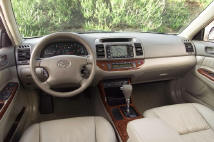When it comes to reputation for quality and
reliability in the automotive world, every manufacturer is chasing
Toyota. In fact, for a time Toyota's quality lead was so great that
Detroit must have thought they were built by aliens. While that gap
has narrowed and in some cases has even been matched, no one can argue
Toyota products are anything but top shelf. The Camry has been a big
part of Toyota's success, and was first introduced as a compact in
1983. Sales grew over the years, and at times the Camry was America's
best selling car. Today, the Camry is larger and much more powerful
than the original. This had been an ongoing trend through every design
change, but apparently ended with the version reviewed here, as later
models are about the same size.
The lineup started with the entry level LE model.
Motive power was provided by a 157hp 2.4L 4-cylinder engine coupled
with a 5-speed manual or a 4-speed automatic transmission. This was a
big improvement over the previous year's 2.2L/136hp powerplant.
Standard features included power front disc brakes, stereo with CD
player, cruise, tilt, full power and manual air conditioning.
The mid range model was designated the SE. This was intended as the
"sporty" version of the Camry. As good as the Camry is, it's pretty
boring and the SE tries to inject a little excitement into the Camry's
DNA. The SE utilizes a suspension dialed toward the
handling/performance spectrum and replaces the LE's 15-inch wheels
with 16-inch wheels with covers. You also get the obligatory "sporty"
rear spoiler, which functionally is worthless, blocks rear vision and
is generally a waste of plastic! Equally worthless is the gold tinted
trim that comes with the SE. Over time, it fades and looks terrible.
Not that it ever looks good in the first place!. Rounding out the
package are fog lights and a leather wrapped steering wheel.
XLE trim designates the top of the line model. It listed at $2,495
more than an LE, but came with a enough extra equipment to justify the
price. Added to the standard equipment lister were automatic air
conditioning, ABS, keyless remote entry, illuminated vanity mirrors,
heated outside mirrors, dual power seats, garage door opener, 16-inch
wheels (still with wheel covers, though), and a JBL stereo with CD and
cassette. The XLE gets a little extra bling inside and out and some
fake wood splashed around the cabin, too. The 5-speed manual
transmission was not available on the XLE.
Optional on all models was a 3.0L-V6 with 192 horsepower. 4-wheel disc
brakes with ABS were part of the package, but the manual transmission
was not available with the six. The V6 also got you alloy wheels on
the SE and XLE models.
The 2002-2005 Camry grew a bit from the previous version and presented
a softer, more rounded design. In typical Toyota fashion, it's
conventional and conservative, but easy on the eyes. It's hard to not
be OK with it, but equally hard to get very excited about it. There
were the usual slight design tweaks during the model run, but the look
was the same.
 The XLE dash.
The XLE dash.
Toyota is exceptionally good at making everyday materials look and
feel richer than they are. This talent is evident inside the Camry, as
mundane plastics are given pleasing textures, heft where needed and
everything that's touched feels like quality. The instrument panel is
simple, logical and attractive, although we can't warm up to the white
faced gauges of the SE. The large center pod declares that this is a
substantial car, and the controls provide excellent tactile feedback
to back that up.
The Camry is a comfortable car for four, and does better than most in
this class with five. The seats are comfortable, although the seat
bottoms might be a little short for drivers with long legs. The
legroom itself, though, is very good.
The Camry has a long list of comfort and convenience options. There
are, of course, the major ones such as power moonroof, leather seats
and navigation system. These could be ordered separately or as part of
a package. Keyless entry was standard only on the XLE, an oversight
that was remedied in the 2003 model. New, adjustable pedals also
arrived as standard equipment in 2003.
The base 2.4L 4-cylinder is smooth, quiet until pushed, and provides
adequate power. The automatic is equally smooth, but a little sloppy
in it's shifts. That's dialed in, as it fits the seamless nature of
the the Camry. The V6 is is exceptionally quiet under all conditions
and provides good acceleration. The six got a size and power boost in
2004, when a new 3.3L-V6 with 225 horsepower was made optional in the
SE model in place of the 3.0L, which also saw a power boost to 210hp.
Both got a new 5-speed automatic.
The suspension gives up a little control for a smooth, almost (but not
quite) floaty ride. The SE dials up the control just a notch. While
not a performance setup by any stretch of the imagination, it does
firm things up a bit while maintaining ride quality.
Fuel economy is very good with the 4-cylinder, regularly achieving
26-28mpg in mixed driving. The V6 delivers 22-26mpg in the same mix,
pretty good for it's size and power. These numbers were a bit above
average for the class at the time.
 Values
Resources
How to Use
Exotics
Classic
MENU ≡
Values
Resources
How to Use
Exotics
Classic
MENU ≡

 The XLE dash.
The XLE dash.